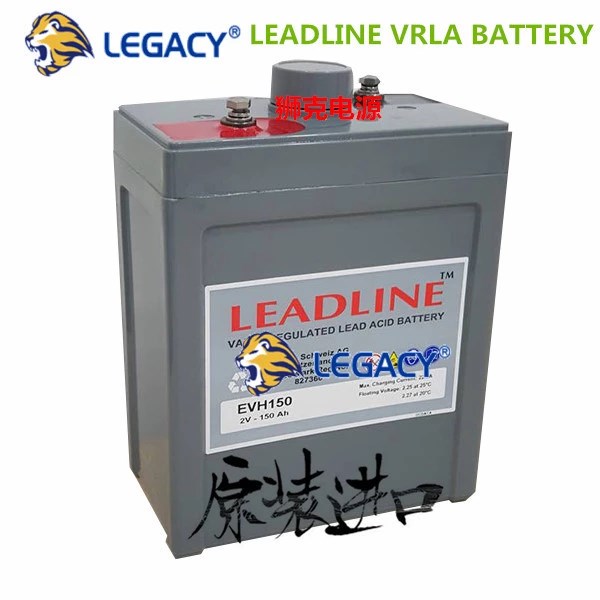瑞士LEADLINE蓄电池性能特点:
< 安全和密封:采用独特的生产工艺和特殊的结构设计,保证电池使用的安全性和密封性。
< 免维护:独特气体再化合系统能将产生的气体再化合成水,吸附式玻璃纤维隔板,在寿命期内无需补充电液。
< 自放电低:使用而腐蚀性好的特殊铅钙合金制成的板栅,把自放电控制在小,室温25℃下储存,可半年之内不用充电。
< 使用温度范围宽:电池可在-15℃~50℃的温度范围内使用。
< 安装方便:可根据用户的要求立放、卧放方式进行安装。
< 长寿命设计:采用耐腐蚀结构的重型铅钙合金极板。

使用和维护
◆参数
可在-15℃~+45℃的环境中使用,推荐使用温度为 25±5℃,在过高或过低温度环境中使用,均会降低电池使用寿命。
◆容量和影响因素
电池在一定放电条件下所能给出的电量称为电池的容量,以符号 C 表示。常见的单位为安培小时,简称安时(Ah)。通常在 C 的下角处标明
放电时率,如 C10 表示 10 小时率的放电容量;C3 表示 3 小时率的放电容量。
电池的容量分为额定容量和实际容量。SST 系列电池的额定容量见表 1-1。实际容量是指电池在一定放电条件下输出的实际电量,它等于放
电电流与放电时间的乘积,单位为 Ah。
蓄电池的放电容量与放电电流、终止电压及放电时的温度直接相关。总的来说,放电电流越小、终止电压越低、温度越高,电池放出的电量
越大。
◆环境温度对容量的影响
温度影响电池的容量。图 3-1 为蓄电池放出容量(10 小时率)与温度的关系曲线;例如温度从 25℃降低到 0℃,容量将下降到额定容量的 80%
左右,同时温度过低,使电池长期充电不足,造成负极 盐化,终导致电池放不出电。如果电池放电时温度不是 25℃,按以下公式换算成 25
℃的容量 C25。
式中:T—放电时的环境温度 CT—温度 T 时的放电容量
k—温度系数,10 小时率放电时 k=0.006/℃ 3 小时率放电时 k=0.008/℃ 1 小时率放电时 k=0.01/℃
随着环境温度的升高,电池容量在一定范围内会增加,例如温度从 25℃升高到 35℃,容量将上升到额定容量的 105%左右,但温度如继续上升,
容量的增加很缓慢,终将不会继续增加。
Switzerland leadline battery performance features:
Safety and sealing: the unique production process and special structure design are adopted to ensure the safety and sealing of the battery.
< maintenance free: the unique gas recombination system can regenerate the generated gas into water, and the adsorption type glass fiber separator does not need to supplement the electro-hydraulic during the service life.
Low self discharge: the grid made of special lead calcium alloy with good corrosiveness can control the self discharge at low temperature and store at 25 ℃ for half a year without charging.
< wide temperature range: the battery can be used in the temperature range of - 15 ℃ ~ 50 ℃.
Easy installation: it can be installed in vertical and horizontal way according to the requirements of users.
< long life design: the heavy-duty lead calcium alloy plate with corrosion-resistant structure is adopted.
Use and maintenance
Parameters
It can be used in the environment of -15 ℃ ~ +45 ℃, the recommended temperature is 25 ± 5 ℃, and it can be used in the environment of too high or low temperature, which will reduce the battery life.
◆ capacity and influencing factors
The amount of electricity that a battery can give under certain discharge conditions is called the capacity of the battery, expressed by the symbol C. The common unit is ampere hour, or ah. Usually indicated at the lower corner of C
Discharge time rate, such as C10, is the discharge capacity of 10 hour rate; C3 is the discharge capacity of 3-hour rate.
The capacity of the battery is divided into rated capacity and actual capacity. See Table 1-1 for rated capacity of SST series batteries. The actual capacity refers to the actual power output by the battery under certain discharge conditions, which is equal to the discharge
The product of electric current and discharge time, in ah.
The discharge capacity of the battery is directly related to the discharge current, the termination voltage and the temperature when discharging. In general, the lower the discharge current, the lower the termination voltage and the higher the temperature, the battery will discharge the electricity
电话:13522350798
公 司:瑞士LEADLINE蓄电池(中国)营销总部